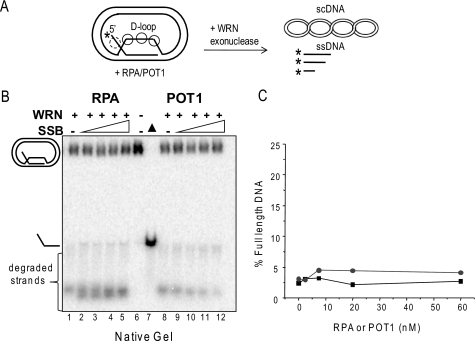FIGURE 5.
RPA and POT1 fail to alter WRN processing of mobile D-loops in the absence of branch migration activity. A, schematic of mobile D-loop disruption by WRN exonucleolytic degradation of the invading strand. The asterisk denotes a radiolabel, and scDNA indicates supercoiled dsDNA. Circles with solid lines represent either RPA or POT1 binding, and circles with dashed lines represent only RPA binding. B, the telomeric mobile D-loop (50 pm) was incubated with 5 nm WRN and increasing concentrations (0, 2.5, 7.5, 20, or 60 nm) of either RPA (lanes 1–5) or POT1 (lanes 8–12) for 15 min under standard reaction conditions except that 2 mm ATP was replaced with 2 mm ATPγS. Reactions were run on a 4–20% native polyacrylamide gel and visualized by PhosphorImager analysis. ▲, heat-denatured substrate. C, the percentage of full-length ssDNA products was calculated as described under “Experimental Procedures” and plotted against RPA or POT1 concentration. Squares and black lines, WRN and RPA; circles and gray line, WRN and POT1.

